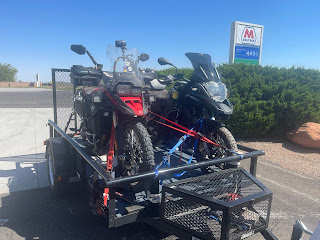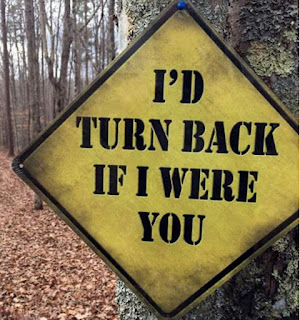Epilogue:
I wanted to do a quick close out on how I finished the ride, how the bike did, how the equipment and other gear I brought along held up and finally the cost of the trip. Hopefully this will help others who plan on such a ride in the future.
I was gone 65 days total and rode almost 14k miles. I took a ferry from Valdez to Whittier, and I trailered my bike with a friend from Arizona to Texas…so that saved more than 1,500 miles of riding. My longest days were 725 on the final stretch and 635 with Steve.
Costs: My wife kept a running tab on what I spent along the way. Though I’d planned to use my Discover card to avoid the foreign transaction fees, almost no one used Discover Card in Canada so I used a Visa… with a fee for every transaction.
These totals are solely for the Canada/Alaska portions:
Fuel: $1000
Food: $1850
Lodging/camping: $975
Misc. (to include bike maintenance): $1175
(NOTE: Tack on another $2000 from the Canadian border back home. I brought $1000 cash with me and returned with less than $20.)
(The exchange rate was pretty good and we got about $1.30 loonies for every US greenback, which was nice in offsetting the crazy costs in the Great White North. In retrospect, the preferred method was exchanging wads of cash, though credit cards were so much more convenient.)
Gear: Most of my equipment worked really well. In retrospect, I could’ve packed fewer clothing items.
Tent: I used the same US Marine Corps tent made by Black Diamond that I used on my Canada/Alaska ride in 2014. It’s about twice as heavy as the lightweight travel tents that others carry but well worth it. It’s considered a 2-person tent, though it’s truly a 1 1/2 man tent, perfect for me and my gear. It has a zinc-lined rainfly that keeps out any moisture; I never had any kind of rain leakage. And that also keeps out the daylight; when it never gets dark up in the Yukon and Northwest Territories, you’ll appreciate having a darkened tent.
Sleeping bag: I ended up taking a less bulky lightweight Recon 3 bag and it did great.
Sleeping bag liner: This lightweight fleece liner that I bought on Amazon for $60 was worth its weight in gold. It absolutely added 10+ degrees to the lightweight sleeping bag.
Sleeping pad: Because I’ve been frustrated over the years with inflatable pads that always go flat in the middle of a ride, I took a TheraRest foam pad. Though bulky and not the easiest to pack on a bike, it was comfortable and sturdy and never let me down.
Helmet: I brought my Shoei NeoTec modular helmet and it did fine. I encountered some grief with fogging issues but I refuse to use a pinlock set-up…
Riding outfit: Probably the best piece of kit I brought was my Aerostich Darien set. The padded GoreTex pants and jacket were waterproof and comfortable in every climate except 117 degree Arizona heat. As well, they are highly protective had I needed them in a fall. I did not use them in that scenario…
Boots: My Sidi Adventure 2 GoreTex boots kept me warm and dry the entire time. And I didn’t feel they were terribly uncomfortable even in hot, hot temps.
Gloves: I brought 4 pair of assorted gloves and 3 of them just weren’t waterproof enough. Sadly, the badass GoreTex gloves I brought just didn’t fit well enough to use when I needed them.
Earplugs: I went through a lot of these. I usually like the silicon versions but they caused irritation after 10 straight days. I switched to foam earplugs and all was fine.
Helmet Bluetooth system: The Sena system I used, mainly for music and GPS directions, was fine, though it only lasted 5-6 hours on a charge.
Hard vs soft bags: We ended up taking soft bags for the off-road safety aspect. My cordura Wolfman panniers were rugged though not waterproof on the outside. The liners were waterproof and kept my gear dry. I did have a locking aluminum top box—mainly to keep out bears and 2-legged troublemakers—and that was handy. NOTE: All things considered, hard side bags would’ve been much more convenient, though they cause a lot of grief if you crash off-road. We made the right choice in bringing soft-sided bags.
Tires: The Dunlop Trailmax Mission tires were the true champs of this ride. They cost me too much to buy ($500+ a set) and to mount/balance ($200+) but they did great on all terrain and surfaces. They performed well in mud, rain, gravel, dirt, bad pavement, etc. And best of all, I have almost 12k miles on them and they’re still looking new! I bought them so I wouldn’t have to swap tires along the way and they were a fantastic choice. Highly recommended. I kept them at or just below the highest recommended PSI.
Seat: I ended up taking my stock/OEM seat so I wouldn’t destroy my nice Sargent seat. I added an AirHawk seat cushion (inflatable) and an Alaska Sheepskin pad on top of that. That combination worked pretty well.
GPS: My Garmin Nav VI did OK, but it was prone to glitches now and again. It’s a known issue that Garmin keeps addressing with replacement units, but I may move to a Garmin Zumo XT to avoid future hassles.
Motorcycle, overall: My 2018 BMW R1200GS Adventure held up well. It was comfortable, powerful and easy enough to maneuver in even the toughest off-road conditions. I was disappointed that my front shock seals were blown on the Dalton, but that’s what happens. As well, I blew a final drive seal in Arizona that was fairly easy to repair. Nothing else failed or gave me grief along the way. I had two 6,200-mile services performed by BMW shops during this ride.
Tools: I needed my modular tool kit a few times along the way and it was perfect for every task. It was a costly purchase when I bought it a few years back but I’ve been very pleased with it since. It’s compact and complete and was handy for the roadside repairs I did along the way.
Camping vs Hotels: We camped about 1/3 of the time…less than we’d planned…for various reasons, mainly convenience. Hotels were expensive in Canada and Alaska but sometimes we just didn’t feel like putting up and taking down our tents in the rain. Splitting costs helped, but hotels were often in the $200 range. NOTE: Many of the campgrounds where we stayed lacked hot showers. Campgrounds with flush toilets and hot showers are almost as good as hotels, but that variety was few and far between. Most campsites were in the $18-25 (Canadian) range.
Lastly, I want to thank those who followed our progress and supported us along the way. Your thoughts, prayers and comments were greatly appreciated. Sure, the ride through the Lower 48, Canada and Alaska was spectacular…but my absolute favorite part of the trip was spending time with family and friends. THAT was super special to me. NOTE: My wife was supportive and forgiving and held down the fort while I was out riding. I can’t express my appreciation for that. Though I do plan to make it up to her somehow…


















































Excellent ride, excellent report, excellent memories. Thanks for taking us along on your adventure of a lifetime.
ReplyDeleteFantastic trip and professional ride review! Thanks for taking the time to share your adventure and welcome home!!
ReplyDelete